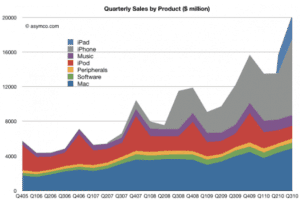
This is from my January 2011 CAMagazine column.
The article was based upon a blog post by Asymco in October of 2010, and includes some commentary from a previous blog post I made on fast changing product life-cycles.
When Apple reported results last fall that blew past analyst expectations, there was a lot of talk about how this innovation juggernaut continues to redefine the technology market.
Yet much of the discussion overlooked a significant factor: 60% of Apple’s revenue came from products that didn’t exist three years prior to the earnings release, according to an analysis of Apple’s revenue by mobile app developer Asymco.
Think about that in the context of your operations. What if you had to replenish your product or service line every two or three years? It could become the new normal in many industries.
One of the most profound changes to come about during the past decade has been the collapse of product life cycles. Think about the graph in your marketing textbook from years or decades ago when you first learned about the concept of product life cycles. Remember how it showed a product coming to market: sales increase, reach market maturity and eventually begin to drop off. That’s been the model of product life cycles as taught in business schools for the past 100 years or so.
The rule of thumb was that companies would innovate and introduce a new product. If it succeeded, the company would experience growth. At some point, sales would peak. The product would then become obsolete or overtaken by competitors and sales would decline. That might involve a time period of 10, 15 or even 25 years.
What a quaint model. Too bad it bears no resemblance to today’s reality. The product life-cycle model today is being turned on its ear by instant obsolescence. In some industries, that product obsolescence now occurs during the growth stage; in the high-tech industry, the decline phase caused by instant obsolescence can occur during the introduction of a product or even before a product makes it to the marketplace.
For example, last year Lenovo pulled the plug on an iPad-like product even before it was released because it was obvious that its limited feature set had already made it irrelevant and obsolete in a very fast-paced market. The product simply had no chance of competing against the iPad. It was killed before it was even produced.
If you want to master innovation, you need to think about how your own product life cycle is changing. Look at the numbers: it took two years for Apple to sell two million iPhones; it took just two months for it to sell two million iPads. And, as my 17-year-old son pointed out when we were chatting about this at the dinner table, it took but a few weeks to sell a million iPhone 4s.
Clearly Apple is on a very significant innovation roll here, but there are lessons to be learned for other organizations. If product life cycles are collapsing in your industry, do you have the capability and wherewithal to generate revenue where revenue hasn’t existed before? Are you prepared to bust into new business models so you can enter markets where you haven’t participated before? Do you know how to add service and other revenue streams to commodity product lines so that you can generate additional revenue from previously stale product lines?
For years, I’ve been preaching to my clients that their ability to survive and thrive in the future is going to come from their ability to generate new sources of revenue and adapt — I covered the issue about a year ago in a column on the concept of chameleon revenue (Netwatch, December 2009). Apple’s numbers indicate that the trend might be picking up steam.




GET IN TOUCH
Jim's Facebook page
You'll find Jim's latest videos on Youtube
Mastodon. What's on Jim's mind? Check his feed!
LinkedIn - reach out to Jim for a professional connection!
Flickr! Get inspired! A massive archive of all of Jim's daily inspirational quotes!
Instagram - the home for Jim's motivational mind!